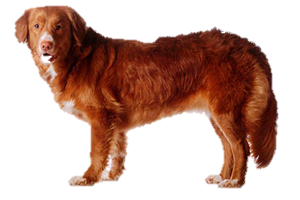Nova Scotia Duck Tolling Retriever
American Duck Retriever, Little River Duck Dog, Little Red Duck Dog, Tolling Retriever, Yarmouth Toller

The Nova Scotia Duck Tolling Retriever is the smallest of the retrievers. The name "Toller" is derived Middle English word “tollen” which means “to draw” or “entice.”
One of only two decoy dogs (the other being the Kooikerhondje), they work quite differently than other gundogs. Their primary function is to lure waterfowl within range of gunshot by playing at the water's edge. A stick or other item is tossed for them to fetch while they scamper and play in silence. They will bounce about, twist in the air, and wave their plume-like tail, sometimes splashing in the water. This dance along the riverbank draws the attention of unsuspecting ducks and gave them the nickname "Pied Piper of the marsh". Once the birds are down the dogs retrieve them for the hunter. This style of hunting is an old practice, and rarely used today. However, the Nova Scotia Duck Tolling Retriever remains an excellent hunting and companion breed.
One of only two decoy dogs (the other being the Kooikerhondje), they work quite differently than other gundogs. Their primary function is to lure waterfowl within range of gunshot by playing at the water's edge. A stick or other item is tossed for them to fetch while they scamper and play in silence. They will bounce about, twist in the air, and wave their plume-like tail, sometimes splashing in the water. This dance along the riverbank draws the attention of unsuspecting ducks and gave them the nickname "Pied Piper of the marsh". Once the birds are down the dogs retrieve them for the hunter. This style of hunting is an old practice, and rarely used today. However, the Nova Scotia Duck Tolling Retriever remains an excellent hunting and companion breed.
Nova Scotia Duck Tolling Retriever Standards
- 17-21"
- 37-51 lbs
- medium-sized retriever
- drop ears are triangular with rounded tips
- tail reaches at least the hock, well feathered
- water repellent coat is medium length with feathering
- any shade red with white markings
History of the Nova Scotia Duck Tolling Retriever
The Nova Scotia Duck Tolling Retriever was developed in Yarmouth County, Nova Scotia, Canada. It is unknown how long they have existed in the region, but they were well established by the early 1800s. Tolling dogs were first mentioned in Canada in 1630 by Nicolas Denys, a French Aristocrat and Explorer, but there is no indication today’s breed is descended from those dogs. Credit regarding their ancestry is often given to the extinct English Red Decoy Dog. However, those dogs were never a breed, but rather similar in type and used for decoy work. Any little red dog that could do the job were used, and the more adapt dogs were bred for the next generation. Spaniels, setters, and retrievers all likely have contributed to the bloodline, but also any number of dogs brought to the New World with European Settlers may have added to the mix. While it is possible the Kooikerhondje played a role somewhere along the line, collies are just as likely. A legend even persists that the fox was included in early matings, due to the way their behavior mimics the wild fox. It persists despite being ruled out genetically.
